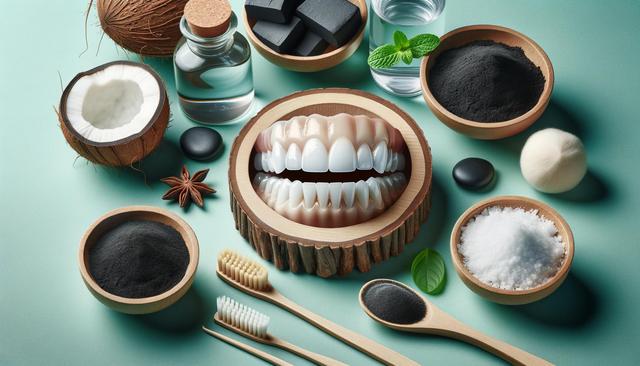Understanding the Causes of Tooth Discoloration
Before diving into natural teeth whitening techniques, it helps to understand why teeth become discolored in the first place. Tooth discoloration can be caused by a variety of factors, both internal and external. Common external causes include the consumption of dark-colored beverages like coffee, tea, and red wine. Smoking or chewing tobacco also significantly contributes to staining. Internal factors, such as aging, certain medications, or excessive fluoride exposure during childhood, can cause deeper discoloration that’s harder to treat.
Some discoloration is extrinsic, affecting the outer enamel, while others are intrinsic, occurring deeper within the tooth. Natural methods are generally more effective on surface stains rather than intrinsic ones. However, with consistent use, many natural remedies can still help improve overall brightness and oral health.
The Role of Diet in Maintaining White Teeth
Diet plays a key role in both the prevention and treatment of tooth discoloration. Certain foods can naturally help cleanse the teeth, while others contribute to staining. Crunchy fruits and vegetables like apples, carrots, and celery act as natural toothbrushes, scrubbing away food particles and plaque. Strawberries, though red in color, contain malic acid, which may help remove surface discoloration.
On the other hand, acidic foods and beverages can erode enamel, making teeth more susceptible to staining. To support natural teeth whitening, consider including the following in your diet:
- Apples and pears for their high water content and fibrous texture
- Leafy greens like spinach and kale, which form a film on teeth that protects against stains
- Dairy products, which contain calcium and phosphorus and may help strengthen enamel
Minimizing sugar intake is also beneficial, as sugar feeds bacteria that produce plaque, one of the culprits behind dull and stained teeth.
Popular Natural Whitening Methods
Several natural techniques have gained popularity for their potential to whiten teeth without the use of synthetic chemicals. One of the most well-known is oil pulling, an ancient practice that involves swishing oil (typically coconut or sesame) in the mouth for 10-20 minutes. This method is believed to reduce bacteria, which may help in stain removal over time.
Baking soda is another commonly used natural abrasive. When used in small amounts and not too frequently, it can help scrub away surface stains due to its mild abrasive properties. Activated charcoal is also used in some home remedies, though its long-term effects and safety are still being studied, so it’s wise to use it sparingly and consult a dental professional beforehand.
Additional natural methods include:
- Brushing with a paste made of baking soda and hydrogen peroxide (occasional use only)
- Using apple cider vinegar diluted with water as a mouth rinse
- Rubbing the inside of a banana peel on teeth, believed by some to help with whitening due to the minerals it contains
How to Practice Safe Whitening at Home
While natural methods can be gentler than commercial whitening products, it’s important to use them safely. Overuse of abrasive substances like baking soda or acidic agents such as lemon juice can wear down enamel, leading to sensitivity and increased risk of cavities. Always dilute acidic substances and limit their use to once or twice a week.
Here are a few safety tips for home whitening:
- Use a soft-bristled toothbrush to avoid enamel erosion
- Do not brush immediately after consuming acidic foods or beverages
- Rinse your mouth with water after using any natural whitening agent
- Consult your dentist before starting any whitening routine, especially if you have dental restorations or sensitive teeth
Patience is key when using natural remedies. Unlike commercial products, which often promise immediate results, natural methods typically require consistent use over several weeks to produce noticeable changes.
When to Seek Professional Advice
While natural teeth whitening methods can support good oral hygiene and reduce surface stains, they may not be effective for everyone. If your discoloration is due to intrinsic factors or if you have dental work such as crowns or veneers, natural methods may not yield visible results. In such cases, it’s best to consult a dental professional who can recommend appropriate treatment options.
Professional cleanings and whitening treatments may be necessary for deeper stains or to achieve more significant changes. A dental visit can also reveal other potential causes of discoloration, such as enamel erosion or early signs of tooth decay, which may require different forms of treatment.
Ultimately, combining natural methods with regular dental check-ups and good oral hygiene practices—brushing twice a day, flossing, and using mouthwash—can help maintain a brighter, healthier smile over time.
Conclusion: Choosing the Right Approach for a Brighter Smile
Natural teeth whitening methods offer a gentle and often cost-effective alternative for those looking to enhance their smile without relying on harsh chemicals. While results may take time and vary from person to person, incorporating thoughtful dietary choices and safe home remedies can contribute to improved oral health and a more radiant appearance. As with any approach to dental care, consistency and caution are essential. Consulting a dental professional before starting any whitening routine ensures that you’re choosing the method that’s right for your individual needs and oral health condition.






